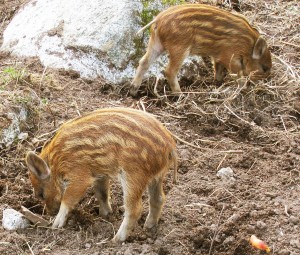So what does boar, fir and falcon say about Frejya?
Let’s look first at the falcon. Freya’s falcon is probably the Gyrfalcon (JER-falcon), the largest falcon, who likes the northern climates. If she migrates at all, she is driven by scarcity of food, and she will sometimes winter at sea over ice. The Gyrfalcon is the preferred falcon for hunting. She mostly hunts birds, including other raptors, although she will also take small mammals. Other predatory birds leave her alone, as she is fierce. She has a varied hunting strategy and is considered very intelligent. The goddess Frejya has a cloak of falcon feathers reaching to the ground. With her characteristic generosity she loans this cloak to the other gods when they need it to move quickly. Falcons in general are associated with the sun or with death. Other important falcon deities include Circe, the witch who trapped Odysseus and changed his sailors into pigs, and Horus, the Egyptian sun god who avenged the death of his father Osiris and performed an important funerary rite for him.

The fir or conifer tree thrives in all but the driest and coldest environments. Conifer forests define “tree line” at extreme latitudes and altitudes, the point where plant growth becomes scrubby. Freya’s fir is the Norway Spruce, which despite its name is prevalent throughout the northern and mountainous regions of Eurasia. Like most spruce trees it is a cold loving tree and it is hardy to the Arctic Circle. It is a particularly beautiful tree that is planted as an ornamental in North America. It grows very tall, 100 feet or more, and typically lives a few hundred years. It produces a nice canopy and is used as a wind breaker. It is a fragrant tree that produces a sweet smelling resin. The cones of the Norway Spruce grow very long, up to 8 inches, and they are quite attractive. The fir’s link with Freya probably comes from the evergreen boughs that decorated halls of feasting during the Winter Solstice observances. These festivities lasted several days or weeks. In a sense, with the great fire, drinking, roast boar, festive attitude, and greenery, Pagans were re-creating Freya’s hall of Sessrymnir, while the dark, cold and frozen landscape outside created a simulation of death. The Norway Spruce used to be the quintessential Christmas tree, although the Scotch Pine works better in today’s commercial environment. Trees in the pine family are associated with winter, rebirth, immortality, strength and sometimes fertility, possibly due to the phallic shape of the cone. Pine has been a preferred wood for coffins due to its association with immortality as well as its availability and workability. Other deities associated with trees in the pine family include the Anatolian Cybele, with her dying and resurrecting lover Attis, the Roman-Persian sun god Mithras, the Greek resurrecting god Dionysus, and the Greek healing god Ascelpius. The pine tree is one of the seven important “chieftan trees” in Celtic druidry, associated with the hero Bran who brought the Irish tales of the isles of paradise in the west.
So this is some background on the boar, fir and falcon. With some reflection you can see how the three fit together to give a deeper understanding of Frejya. I will examine the connection between the three more thoroughly in next week’s post.
